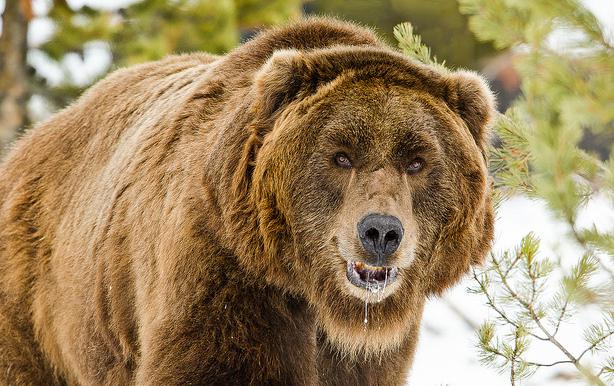Lord Grizzly
Bears are back in town.
Last fall, a bowhunter was stalking elk in the Madison Range. He crept through the dim, morning light as gusty winds pelted him with snow and rain. As with any hunt, success required surprise. But he was so well camouflaged he would share the surprise with the wrong animal.
As he moved up the canyon floor, he nearly stepped on a sleeping grizzly bear. The hunter's world exploded. The bear, furious from the surprise, clamped its jaws on man's head. Just like the grizzly scene from The Revenant, when Hugh Glass surprised the sow griz and its cubs. The roar. The power of unrestrained fury. We all hope it never happens to us.
Today, the northern Rockies host a burgeoning grizzly population that is at all-time recovery highs, a density probably not seen since Hugh Glass's fur-trapping days. The region has some 1,500 individuals; the Yellowstone Ecosystem itself now holds over 700 bears, recovering from a low point in 1970s. This growing population already raises the chances of you encountering a bear. About the only way to make it more exciting is to steal through bear habitat as quietly as possible, the way of a successful hunter.
Grizzlies make the outdoors bigger than us. We have a lot of risk options for our outdoor sporting enjoyment. Scratch your way up a sketchy climb, huck your flesh off a cornice, drop into the maw of a steep rapid; no matter, our sports never exceed us. If something happens, you've either fallen short in your ability, made a mistake, or miscalculated the risk.
Risk is different when you are in the company of grizzly bears. For starters, this handsome poster-child of wilderness has one significant character flaw: it is prone to temper tantrums. And who can calculate that risk? Facing an angry bear, you may find that your fear overwhelms your reasoning powers—fight or flight—just as the bear's hair-trigger anger has overpowered its reasoning. Your reaction in the moment may skew the odds.
But, that is the point—grizzlies are able to reason at some level. Beyond that not-so-trivial aspect of dangerous encounters, they are special because no other critter in the wild outdoors compares when we consider their intelligence. You are in the company of thinking animals, and you are in their home.
In Tracking Without a Gun, the early-20th-century naturalist Enos Mills tracks a boar griz, Old Timberline, along an alpine ridgeline in Colorado. He relates an epic day when the hunter becomes the hunted. Mills describes the grizzly as alert and wary, almost impossible to predict or anticipate because of its intelligence.
Mills verifies the findings of more recent studies that most potential encounters never happen because the grizzly typically leaves before the humans realize it was close. When grizzlies hear or smell us with ample warning, they generally hightail it. Mills adds that "when a grizzly discovers that he is followed, or even if he only thinks himself followed, he at once hurries off to some other part of his territory." Old Timberline was different.
Mills decides to track Old Timberline and realizes the bear has thrown him. Old Timberline cleverly obscures his trail in a way the renowned naturalist has never seen before. Beyond knowing that it leaves a scent trail, he writes, the grizzly "appears to be fully aware that he is leaving tell-tale tracks" which a hunter can follow. Through turns and backtracking, the grizzly "tramples about to leave a confusion of tracks where they do show."
If you've ever had the chance to meet a griz in Hayden Valley or up on a ridgeline where there aren't any trees to climb, you can imagine how Mills felt when he discovered Old Timberline was trailing him. The tables had turned. The hunter was the hunted.
The bear's calculating and deliberate maneuver shook Mills. "Hunters trailing a wounded grizzly," he writes, "have been ambushed and killed. But this grizzly had not even been shot at nor harassed." Being human, Mills does the natural thing and goes back to tracking the griz. But he never recoups his initial advantage. As he tries to return to the hunter's position, he discovers Old Timberline is one step ahead of him and has anticipated this maneuver. The bear has backtracked and hidden behind a boulder in ambush.
"Often a grizzly, if he feels he is not yet seen," writes Mills, "will slip around to follow those who are trailing him." But if they know they've been seen, Mills can think of no other situation when a bear hung around. That makes the situation with Old Timberline all the more intense. "After Old Timberline discovered that I had circled behind him, he knew that I knew where he was and what he was doing." And that's enough for the bear. He circles and sets up with obvious intent to ambush.
Grizzly bears, Mills writes, are "master[s] of strategy." He remembers the times he outwitted bears, but admits that "more frequently [the bears have] outwitted me. Every grizzly has speed, skill and endurance. He has mental capacity and often shows astounding plan, caution, courage, and audacity."
This time, with Old Timberline, the hunter is again deceived. Mills retreats and makes camp between a rock wall and a large fire.
As a hunter "without a gun" who deliberately trails a grizzly, Mills illuminates the complex nature of our companion backwoods drifter, the grizzly. Today, we have a lot to learn about the new generations of grizzlies that are reoccupying the northern Rockies. Most often, we see them through a single frame, that being the fear of an encounter. The grizzly bears are back home. If we're going to cohabitate, we need to improve our understanding of them as intelligent animals with distinctive personalities.











